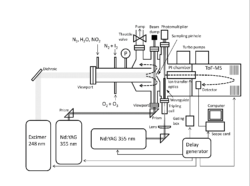Absorption cross-sections of iodine oxides
Iodine oxides (IxOy) play an important role in the atmospheric chemistry of iodine, initiating new particle formation events in the coastal and polar boundary layer and acting as iodine reservoirs in tropospheric ozone-depleting chemical cycles. Iodine-containing molecules are emitted into the lower atmosphere from the sea surface and marine flora. The atmospheric chemistry of iodine is involved in ozone depletion and new particle formation, two important tropospheric background processes. The main atmospheric fate of the iodine atoms is reaction with ozone to form iodine monoxide (IO) which either photolyses, creating an ozone-neutral cycle, or reacts with a second IO molecule to form OIO and I. OIO then undergoes reaction with IO or another OIO molecule, forming I2O3 and I2O4 respectively. Further steps in this scheme lead to the formation of higher iodine oxides, which aggregate to form Iodine Oxide Particles (IOPs). Despite the importance of these iodine containing compounds, their photochemistry has not been studied in detail previously.
Work is being carried out at the University of Leeds, in conjunction with the Atmospheric Chemistry and Climate group at CSIC in Madrid to investigate the absorption cross-sections of a suite of these iodine oxide compounds, using Pulsed Laser Photolysis - Time of Flight Mass Spectrometry.
O atoms are generated via flash photolysis of O3 in the presence of I2 to form IO, which rapidly undergoes self-reaction to form OIO, initiating the chemistry leading to the formation of the species of interest: higher iodine oxides (IxOy). To measure the absorption cross sections of the species of interest, a third laser is directed in front of the pinhole, in order to photolyse a fraction of the material being sampled. The magnitude of the depletion is compared to an analogous experiment with an absorber with a well defined absorption cross section (NO2), facilitating the calculation of an absorption cross-section for each species at the wavelength of the photolysis laser.
The assessment of the impact of atmospheric IxOy photolysis is ongoing, and will employ a 3D CAM model to investigate the potential impact that this photochemistry has on ozone depletion and new particle formation.

